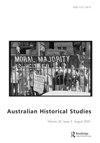间谍和麻雀:ASIO和冷战
IF 0.6
3区 历史学
Q1 HISTORY
引用次数: 0
摘要
我撰写了第二卷(抗议年代),并与里斯·克劳利(Rhys Crawley)合著了第三卷(秘密冷战),讲述了澳大利亚安全情报组织(ASIO)的官方历史,我觉得我对ASIO及其从1949年到1989年的头40年有了很好的了解。我惊喜地发现了菲利普·迪尔设法揭露的真相,以及故事讲述的引人入胜的方式,围绕着对信任的反复担忧:盟友、同事、联络人、特工和目标之间的信任。这本书解释了冷战开始的澳大利亚背景,以及解密的苏联外交信息(代号为“维诺娜”)的重要性,这些信息引发了澳大利亚“间谍巢穴”的惊人揭露。他们的存在,以及对敏感文件的高层访问,让人质疑澳大利亚作为美国和英国值得信赖的安全伙伴的可靠性。1949年,随着冷战看起来有可能演变成另一场热战,这些担忧似乎是真正的。这些事件将导致ASIO效仿英国军情五处的模式成立。Deery重新审视了其他人强调的问题:ASIO成立的目的是抓住这些间谍,恢复澳大利亚的国际地位,但它对少数“非法”或秘密的共产主义者几乎没有什么有意义的区别……以及成千上万的澳大利亚共产党成员和“同路人”,他们每天都沉浸在为社会正义而斗争中(7)。随着1956年匈牙利起义和1968年布拉格之春的镇压,曾经强大的澳大利亚共产党(CPA)逐渐迷失了方向,使CPA奄奄一息,这个问题变得更加严重。顽固的革命者转向较小的分裂组织,如托洛茨基主义社会主义工人联盟(SWL)和社会主义青年联盟(SYA)。Deery不是通过组织本身的棱镜,而是通过那些被雇佣为间谍和麻雀的人(即由ASIO官员雇佣和处理的卧底ASIO特工)以及受其影响的人,提供了一个迷人而重要的视角。为了从不同的角度阐明这项任务,Deery挑选了8名候选人,他们的背景、技能、动机和经历都截然不同。首先是雷达和无线电物理学家汤姆·凯泽(Tom Kaiser),他被视为“同行者”,不得不被解雇,因为他是“澳大利亚进入美国和英国高科技武器系统和原子发展的高度机密世界所付出代价的一部分”。下一位是威廉·多布森,他是反共的澳大利亚工党(ALP)工业集团的成员,该集团被称为石斑鱼。他既没有被ASIO当作麻雀招募,也没有被视为对国家安全的威胁,他的行为“鲜明地反映了信任和背叛的双重问题”。第三个是保罗·鲁本·詹姆斯的故事,他是“澳大利亚冷战的一个小受害者”,因为谴责《共产党解散法案》而被免职。他的案子是孟席斯政府执政初期对澳大利亚政治需求的试金石。第四名是安妮·尼尔。这位保守的,常去教堂的君主主义者和战争寡妇是谦逊的,被证明是ASIO最有效的麻雀之一。她讨好澳大利亚注册会计师协会的南澳大利亚分会。她显然是一个有良心的党员,她被邀请到中国和苏联作为会计师事务所的代表。最终,人们开始怀疑她是如何负担得起参加如此广泛的会议的(这是ASIO为她提供的资金)。之后,她公开了自己的想法。她的“背叛”招致了尖刻的批评。Deery认为,在阿德莱德追求CPA的过程中,亚洲正在“向风车倾斜”。也许是这样,但阿德莱德是1963年驱逐俄罗斯人伊万·斯克里波夫(Ivan Skripov)事件的发生地。本文章由计算机程序翻译,如有差异,请以英文原文为准。
Spies and Sparrows: ASIO and the Cold War
Having authored the second volume (The Protest Years) and co-authored the third volume with Rhys Crawley (The Secret Cold War) of the official history of the Australian Security Intelligence Organisation (ASIO), I felt I had a good grasp on ASIO and its first four decades from 1949 to 1989. I was pleasantly surprised at what Phillip Deery managed to uncover and the engaging way the story is told, revolving around the recurring concern over trust: between allies, colleagues, handlers, agents and targets. The book explains the Australian context to the Cold War onset and the significance of decrypted Soviet diplomatic messages (codenamed ‘Venona’) which prompted startling revelations about a ‘nest of spies’ in Australia. Their presence, with high-level access to sensitive documents, brought into question the reliability of Australia as a trusted US and UK security partner. In 1949, with the Cold War looking likely to turn into yet another hot war, these appeared to be genuine concerns. These events would lead to the creation of ASIO, following the mould of its British counterpart, MI5. Deery revisits the problem that others have highlighted: once created to catch these spies and rehabilitate Australia’s international standing, ‘ASIO made little meaningful distinction between the small handful of “non-legal” or covert communists... and the thousands of CPA members and “fellow travellers” who immersed themselves in daily struggles for social justice’ (7). That problemwas exacerbated as the once mighty Communist Party of Australia (CPA) progressively lost its way following the suppression of the Hungarian uprising in 1956 and the Prague Spring in 1968, leaving the CPA moribund. Die-hard revolutionaries moved to smaller breakaway groups like the Trotskyist Socialist Workers League (SWL) and Socialist Youth Alliance (SYA). Deery provides a fascinating and important look at ASIO, not through the prism of the organisation itself, but through that of those who were employed as spies and sparrows (that is, undercover ASIO agents hired and handled by ASIO officers) as well as those affected by their handiwork. To shed light on the task from a variety of angles, Deery selected eight candidates, all with strikingly different backgrounds, skills, motives and experiences. First is the radar and radio-physics scientist, Tom Kaiser, seen as a ‘fellow traveller’ who had to be dismissed as ‘part of the price paid for the Australian access into the highly coveted secret world of American and British high technology weapons systems and atomic development’. Next is William Dobson, a member of the anticommunist Australian Labor Party (ALP) Industrial Group, known as the Groupers. Neither recruited by ASIO as a sparrow nor regarded as a threat to national security, his actions ‘starkly silhouette the twin issues of trust and betrayal’. Third is the story of Paul Reuben James, ‘a minor casualty of Australia’s Cold War’, who was dismissed without recourse for having condemned the Communist Party Dissolution Bill. His case is a ‘litmus test of the political imperatives in Australia’ early in Menzies’ government. Fourth is Anne Neill. This conservative, church-going monarchist and war widow was self-effacing and proved to be one of ASIO’s most effective sparrows. She ingratiated herself with the South Australian branch of the CPA. She was such an apparently conscientious Party member that she was invited to China and the Soviet Union as a CPA representative. Eventually, suspicions arose over how she could afford to go to conventions far and wide (which ASIO funded for her). Afterwards, she went public. Her ‘betrayal’ generated vitriol. Deery suggests that in pursuing the CPA in Adelaide, ASIOwas ‘tilting at windmills’. Perhaps so, but Adelaide was the site of concern relating to the expulsion of Russian Ivan Skripov in 1963.
求助全文
通过发布文献求助,成功后即可免费获取论文全文。
去求助
来源期刊

AUSTRALIAN HISTORICAL STUDIES
HISTORY-
CiteScore
0.70
自引率
16.70%
发文量
86
期刊介绍:
Australian Historical Studies is a refereed journal dealing with Australian, New Zealand and Pacific regional issues. The journal is concerned with aspects of the Australian past in all its forms: heritage and conservation, archaeology, visual display in museums and galleries, oral history, family history, and histories of place. It is published in March, June and September each year.
 求助内容:
求助内容: 应助结果提醒方式:
应助结果提醒方式:


